List of 8 Hummingbirds in Maryland
- Ruby-Throated Hummingbird (most common)
- Black-Chinned Hummingbird
- Rufous Hummingbird
- Calliope Hummingbird
- Anna’s Hummingbird
- Allen’s Hummingbird
- Broad-Tailed Hummingbird
- Costa’s Hummingbird
While some of these are rarer or seen during migration, they can occasionally be found throughout the state.
Overview & Details
Maryland is home to a variety of hummingbird species, with the Ruby-Throated Hummingbird being the most common. Other species occasionally spotted include the Black-Chinned, Rufous, Calliope, and Anna’s Hummingbirds. These tiny birds are admired for their vibrant colors, incredible agility, and long migration journeys, with some species traveling thousands of miles. Maryland’s gardens and woodlands provide ideal habitats for them, especially during migration seasons, where they feed on nectar from native plants and flowers. Proper conservation efforts help protect their habitats and food sources.
Ruby-Throated Hummingbird: The Jewel of Eastern North America
Scientific Name: Archilochus colubris
Size: 7.5–9 cm (3–3.5 in)
Weight: 2–4 g (0.07–0.14 oz)
Lifespan: 3–5 years
Diet: Nectar, small insects, spiders
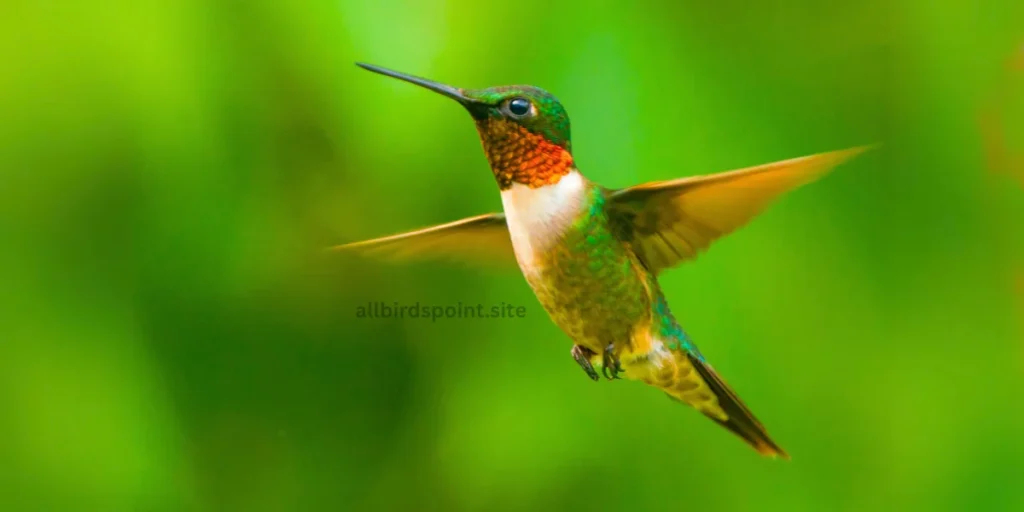
Appearance
The male Ruby-Throated Hummingbird dazzles with its iridescent ruby-red throat, contrasted by metallic green feathers on its back. Females are more subtle, with green backs and white underbellies. Both are small and delicate, yet vibrant.
Migration Habits
These hummingbirds undertake an impressive migration, traveling over 2,000 miles from their breeding grounds in eastern North America to Central America. Their most notable journey includes a 500-mile non-stop flight over the Gulf of Mexico, showcasing their endurance.
Nesting
Female Ruby-Throated Hummingbirds are meticulous builders. They use soft materials like plant down and spider silk to craft their tiny, expandable nests on slender branches. Each nest is the perfect size for their two small eggs, no bigger than peas.
Feeding Behavior
Ruby-Throated Hummingbirds primarily feed on the nectar of brightly colored flowers, favoring red and orange blooms. They also consume small insects and spiders, which provide essential protein. Their hovering flight while feeding is a remarkable sight, as they zip between flowers with incredible precision.
Behavior and Personality
Despite their small size, these hummingbirds are bold and energetic. Males are fiercely territorial, often defending their feeding spots with swift dives and aggressive displays. Their buzzing flight and sharp chirps are common sounds around gardens where feeders or flowers are abundant.
Habitat
Ruby-Throated Hummingbirds are commonly found in gardens, forests, and meadows, especially in areas with abundant nectar sources. They are frequent visitors to hummingbird feeders in backyards, drawn by the easy access to sugar water. These birds prefer habitats that offer plenty of flowers, open spaces, and tree cover for nesting.
| Category | Details |
|---|---|
| Status | Least Concern |
| State Status | Common in eastern U.S., including Maryland |
| Wingspan | 8–11 cm (3–4.3 in) |
| Sound | Fast, high-pitched chip notes and rapid wing beats |
| Appearance | Males have iridescent red throats, green backs; females are green with white underparts |
Black-Chinned Hummingbird: The Quiet Gem
Scientific Name: Archilochus alexandri
Size: 8–9 cm (3.15–3.5 in)
Weight: 3–3.5 g (0.10–0.12 oz)
Lifespan: Up to 10 years
Diet: Nectar, small insects, spiders
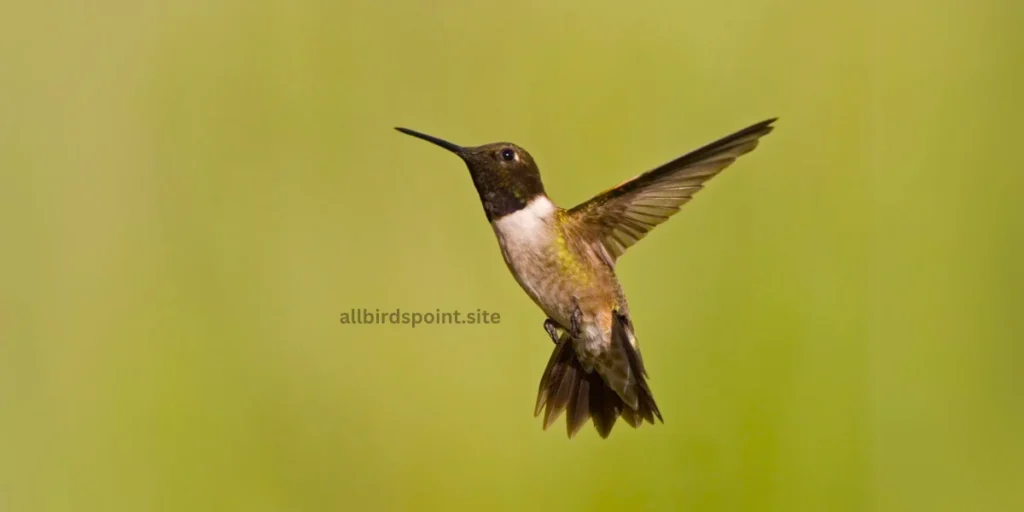
Appearance
Male Black-Chinned Hummingbirds are known for their black throats with a subtle, purple band at the base. Their backs are metallic green, while females are lighter with a white throat and pale green backs. Though less flashy than other species, their understated beauty shines in the right light.
Migration Habits
Black-Chinned Hummingbirds are strong migrants, moving from their breeding grounds in the western U.S. to wintering areas in Mexico. While not as widely distributed in the east, some can be spotted during migration, even in Maryland. They make their way through various habitats, from deserts to forests, in search of food and shelter.
Nesting
Females build nests out of soft materials like plant fibers, spider silk, and down, carefully placing them on tree branches or shrubs. The nests are well-hidden and expandable, perfect for accommodating their growing chicks. Females lay two tiny eggs, similar in size to jellybeans, and care for the chicks until they are ready to leave the nest.
Feeding Behavior
Like other hummingbirds, Black-Chinned Hummingbirds primarily feed on nectar from flowers and feeders. They have long, slender beaks perfect for reaching deep into tubular flowers. Insects and spiders are also important parts of their diet, providing the protein needed for energy. Despite their small size, they can be quite territorial, often chasing away other birds from their favorite food sources.
Behavior and Personality
Black-Chinned Hummingbirds are more reserved compared to the bolder Rufous species. They are generally quiet and subtle, but their aerial displays during courtship and territorial defense are impressive. Males perform diving displays to attract females and show off their flying skills. Their fast wingbeats, combined with soft vocalizations, make them a joy to observe in the wild.
Habitat
These hummingbirds are adaptable and can thrive in a wide range of environments. They are often found in open woodlands, canyons, and gardens. During migration, they stop in areas with abundant flowers or feeders, taking advantage of the food available to fuel their long journeys.
| Category | Details |
|---|---|
| Status | Least Concern |
| State Status | More common in western U.S.; rare in Maryland |
| Wingspan | 9–11 cm (3.5–4.3 in) |
| Sound | Soft, ticking sounds and rapid wing beats |
| Appearance | Males have a black chin with a purple base; females are green with white throats |
Rufous Hummingbird: The Fiery Traveler
Scientific Name: Selasphorus rufus
Size: 7–9 cm (2.8–3.5 in)
Weight: 2–5 g (0.07–0.17 oz)
Lifespan: 5–8 years
Diet: Nectar, small insects, spiders

Appearance
Male Rufous Hummingbirds are famous for their bright, fiery orange feathers and iridescent red throats, giving them a striking and vibrant appearance. Females, although not as bold in color, are still beautiful, with mostly green backs and rufous coloring on their sides and tails. The contrast of these colors makes them easy to identify, especially when the sun hits their feathers.
Migration Habits
Rufous Hummingbirds are incredible travelers. They migrate over 2,000 miles, flying from as far north as Alaska to Mexico during the winter. These small birds are incredibly tough, covering vast distances with their powerful, quick wingbeats. Their ability to migrate long distances makes them one of the toughest birds for their size. Along their journey, they stop to feed on nectar and insects to keep their energy up.
Nesting
Female Rufous Hummingbirds are expert builders. They use soft materials like plant fluff, moss, and spider silk to weave their tiny, flexible nests. These nests are small but stretchy, which allows room for the growing chicks inside. The nests are usually built in hidden spots, like the branches of trees or shrubs, to protect their eggs from predators. Watching them work on their nest is a fascinating process, showing off their precision and care.
Feeding Behavior
Rufous Hummingbirds are not just beautiful; they are also fiercely territorial. They are known for chasing away other birds from their favorite flowers and feeders, even birds much larger than themselves. Their main source of food is the sweet nectar from brightly colored flowers, especially red or orange ones, like columbine or honeysuckle. But they also eat small insects and spiders, which give them the protein they need to grow strong and stay energetic. Their quick, darting movements and hovering flight make them exciting to watch as they feed.
Behavior and Personality
Despite their small size, Rufous Hummingbirds have big personalities. They are known for being aggressive and brave, often chasing away other birds, even those much bigger than them. Their quick, high-pitched chirps and buzzes are common sounds near feeding areas. Watching a Rufous Hummingbird in action is a true spectacle, as their bright colors and energetic behavior bring life to any garden.
Habitat
Rufous Hummingbirds are adaptable and can live in a wide range of habitats. They are often found in forests, meadows, and gardens. During migration, they pass through many different environments, stopping wherever they can find food. They are frequently seen in backyards with hummingbird feeders and brightly colored flowers that provide them with the nectar they love.
| Category | Details |
|---|---|
| Status | Least Concern |
| State Status | Occasional migrant through Maryland |
| Wingspan | 11 cm (4.3 in) |
| Sound | High-pitched squeaky calls and rapid wing beats |
| Appearance | Males are bright orange with iridescent throats; females have green backs and rusty sides |
Calliope Hummingbird: The Smallest North American Hummingbird
Scientific Name: Selasphorus calliope
Size: 7–9 cm (2.8–3.5 in)
Weight: 2–3 g (0.07–0.11 oz)
Lifespan: 4–6 years
Diet: Nectar, small insects, spiders
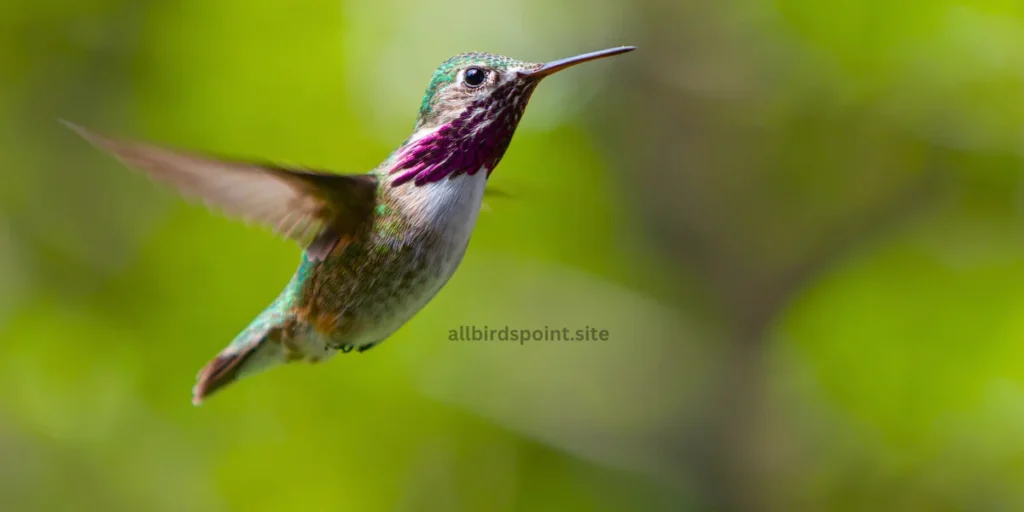
Appearance
The Calliope Hummingbird, the smallest bird found in North America, is known for its tiny stature and distinctive features. Males have striking magenta streaks on their throats, while females are more modest with greenish backs and white underbellies. Despite their small size, they are full of energy.
Migration Habits
Calliope Hummingbirds are long-distance migrators, traveling from their breeding grounds in the western U.S. and Canada to their wintering spots in Mexico. This incredible journey covers thousands of miles, and they rely on nectar from flowers along the way to fuel their flights.
Nesting
Females build nests on low-hanging branches, carefully weaving them from plant fibers, moss, and spider silk. The nests are tiny but strong and can stretch as the chicks grow. Each nest typically holds two eggs, which the female incubates and cares for.
Feeding Behavior
Calliope Hummingbirds primarily feed on nectar from tubular flowers but also catch small insects in mid-air or from spider webs. They hover gracefully while feeding, using their long beaks to sip nectar. Their fast metabolism requires them to eat frequently, making them active feeders throughout the day.
Behavior and Personality
Despite their small size, Calliope Hummingbirds are known for their bravery and assertiveness. Males are particularly territorial and can be seen chasing away much larger birds to defend their food sources. Their buzzing flight and sharp chirping noises make them easy to identify.
Habitat
Calliope Hummingbirds are typically found in mountain meadows, open forests, and sometimes backyards with flowering plants and feeders. During migration, they are more likely to visit gardens with rich nectar sources. Their preferred habitats provide plenty of flowers, insects, and quiet spaces for nesting.
| Category | Details |
|---|---|
| Status | Least Concern |
| State Status | Rare in Maryland, more common in western U.S. |
| Wingspan | 11–13 cm (4.3–5.1 in) |
| Sound | High-pitched, thin chip notes |
| Appearance | Males have magenta streaks on the throat; females are green with white underbellies |
Anna’s Hummingbird: The Year-Round Resident
Scientific Name: Calypte anna
Size: 10–11 cm (3.9–4.3 in)
Weight: 3–4 g (0.1–0.14 oz)
Lifespan: Up to 8 years
Diet: Nectar, small insects, spiders
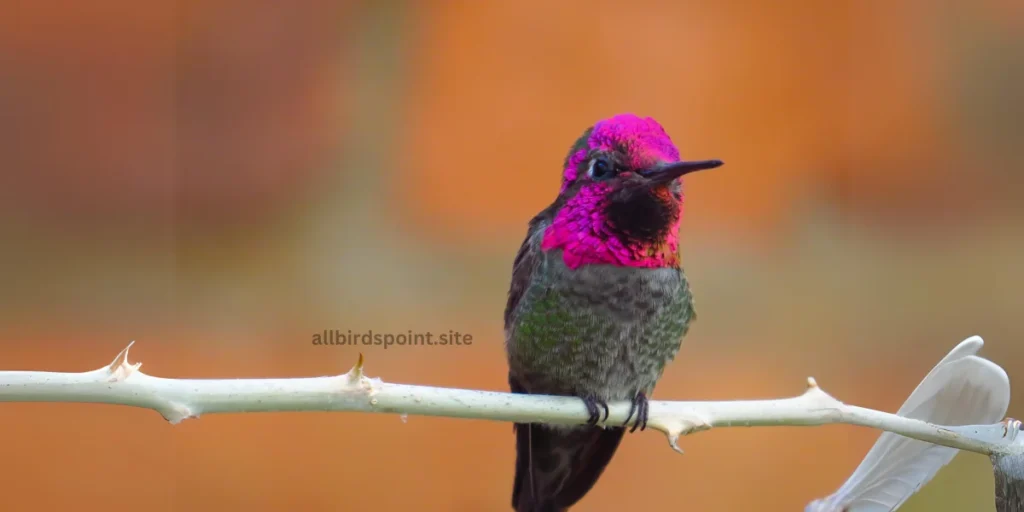
Appearance
Anna’s Hummingbird is known for its beautiful iridescent green body and bright, rose-pink throat (gorget) in males. Females are more subdued, with green backs and grayish-white underbellies. This species is larger compared to other hummingbirds.
Migration Habits
Unlike many hummingbirds, Anna’s Hummingbird is a year-round resident in parts of the western U.S., particularly along the Pacific Coast. Some may migrate locally depending on weather and food availability.
Nesting
Females build their nests from plant materials like downy fibers and spider silk, usually in trees or shrubs. These nests are carefully constructed and expand as the chicks grow. Each nest holds two to three eggs, which the female incubates for about two weeks.
Feeding Behavior
Anna’s Hummingbirds feed primarily on nectar from flowers, especially those with tubular shapes. They also hunt small insects and spiders for protein. They are frequent visitors to hummingbird feeders, particularly during winter when flowers may be scarce.
Behavior and Personality
These hummingbirds are known for their aggressive and territorial nature. Males perform elaborate courtship displays, diving from heights with rapid chirping sounds to attract females. They are also highly vocal, making more noise than most other hummingbirds with a variety of calls and songs.
Habitat
Anna’s Hummingbirds are versatile and can be found in a range of habitats, including urban areas, parks, gardens, forests, and coastal areas. Their ability to adapt to different environments has contributed to their increasing presence in human-populated areas, where they often visit feeders and flowering plants.
| Category | Details |
|---|---|
| Status | Least Concern |
| State Status | Year-round resident on the West Coast; rare in Maryland |
| Wingspan | 12 cm (4.7 in) |
| Sound | Chirpy, metallic-like sounds |
| Appearance | Males have iridescent rose-pink throats and crowns; females are green with pale undersides |
Allen’s Hummingbird: The Coastal Flyer
Scientific Name: Selasphorus sasin
Size: 9–10 cm (3.5–4 in)
Weight: 2–4 g (0.07–0.14 oz)
Lifespan: 4–6 years
Diet: Nectar, small insects, spiders

Appearance
Male Allen’s Hummingbirds are vibrant, with copper-colored backs and throats that shimmer in fiery orange. Females are more muted, with greenish backs and lighter underparts. Despite their small size, their colors make them easy to spot along the coast.
Migration Habits
These hummingbirds are mainly found along the Pacific coast. They migrate from Southern California to Mexico, though some remain in coastal areas year-round. Allen’s Hummingbirds are early migrators, arriving at breeding grounds before many other species.
Nesting
Female Allen’s Hummingbirds build small nests in shrubs or trees, using soft plant fibers and spider silk. The nests are sturdy yet flexible, and usually hold two eggs. The female takes full responsibility for incubation and chick care.
Feeding Behavior
Like other hummingbirds, Allen’s Hummingbirds feed on flower nectar and small insects. They prefer brightly colored, tubular flowers. Their hovering ability allows them to feed efficiently, and they often defend their feeding territory fiercely, chasing away other hummingbirds and larger birds.
Behavior and Personality
Allen’s Hummingbirds are known for their high-energy behavior and aggression when defending territory. Males perform spectacular courtship displays, with rapid, swooping dives and buzzing sounds. Despite their tiny size, they are highly territorial, especially during the breeding season.
Habitat
Allen’s Hummingbirds are typically found in coastal scrub, gardens, and woodlands. They thrive in areas with abundant flowers, often near the Pacific coastline. Their habitats must provide plenty of food sources, including both nectar and insects, to support their energetic lifestyle.
| Category | Details |
|---|---|
| Status | Near Threatened |
| State Status | Uncommon in Maryland, coastal U.S. species |
| Wingspan | 11 cm (4.3 in) |
| Sound | High-pitched twittering and buzzing |
| Appearance | Males are coppery with a reddish-orange throat; females are green with light rufous coloring |
Broad-Tailed Hummingbird: The Mountain Marvel
Scientific Name: Selasphorus platycercus
Size: 10–11 cm (4–4.3 in)
Weight: 3–4 g (0.1–0.14 oz)
Lifespan: 5–6 years
Diet: Nectar, small insects, spiders
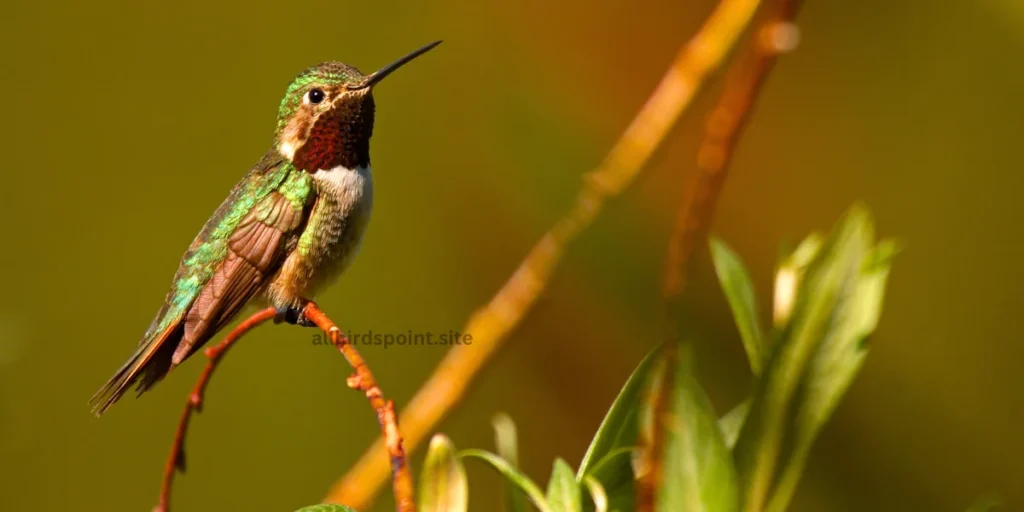
Appearance
Male Broad-Tailed Hummingbirds are known for their bright green backs and rosy-pink throats. Females and juveniles have green backs with pale underbellies, lacking the colorful throat patch but still bearing a sleek, iridescent look.
Migration Habits
These hummingbirds breed in the high mountains of the western U.S., migrating to Mexico during the winter. They are known to tolerate cooler temperatures and are often seen at elevations up to 10,000 feet during the breeding season.
Nesting
Females build nests high in trees, using soft materials like plant down and spider silk to form small, sturdy nests. These nests are often found in open woodlands or mountain forests, providing protection from predators.
Feeding Behavior
Broad-Tailed Hummingbirds feed primarily on nectar from flowers like columbine, larkspur, and sage. They also catch small insects mid-air to supplement their diet with protein. During the breeding season, males produce a distinctive metallic trill sound with their wings as they hover around feeding areas.
Behavior and Personality
These birds are territorial and will defend feeding areas aggressively. Males are known for their aerial displays during courtship, where they dive and make loud wing sounds to attract females. Despite their small size, they are bold and active, often seen darting between flowers in search of food.
Habitat
Broad-Tailed Hummingbirds are typically found in high-altitude meadows, forests, and mountain regions. They prefer open areas with plenty of flowering plants that provide nectar. During migration, they move through a range of habitats, including deserts, woodlands, and gardens, wherever food is plentiful.
| Category | Details |
|---|---|
| Status | Least Concern |
| State Status | Rare in Maryland; found mainly in mountainous regions of the West |
| Wingspan | 12 cm (4.7 in) |
| Sound | Metallic trill made by wings in flight |
| Appearance | Males have iridescent pink throats and green backs; females are green with pale underparts |
Costa’s Hummingbird: The Desert Jewel
Scientific Name: Calypte costae
Size: 8–9 cm (3.1–3.5 in)
Weight: 2–3 g (0.07–0.11 oz)
Lifespan: 5–8 years
Diet: Nectar, small insects, spiders
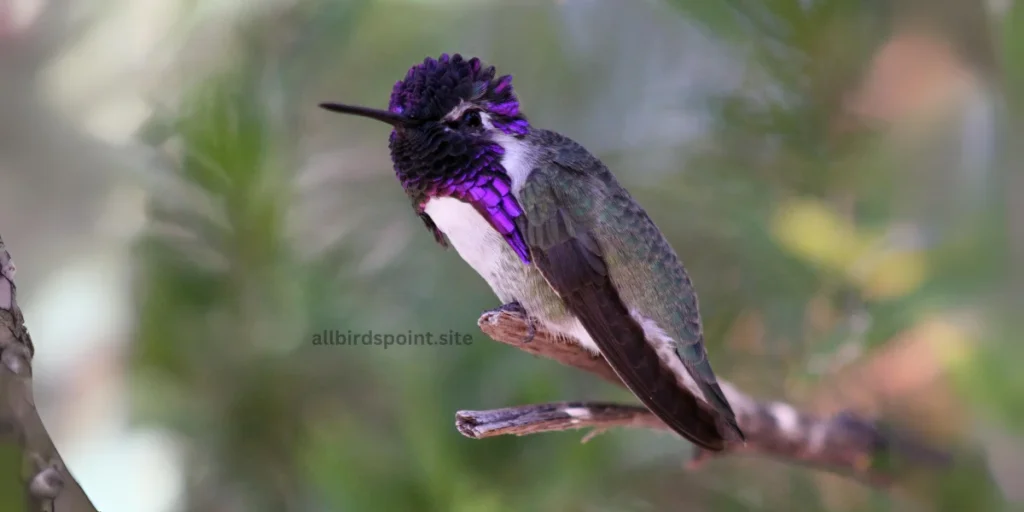
Appearance
Male Costa’s Hummingbirds are striking with their vibrant violet crown and throat that flare out into a unique “moustache” shape. Females are more subdued, with greenish backs and white underbellies, but they still carry a hint of iridescence.
Migration Habits
Costa’s Hummingbirds primarily reside in the deserts of the southwestern U.S. and Mexico, but they may migrate short distances depending on the season. Their ability to thrive in harsh, arid environments sets them apart from other species.
Nesting
Females craft their nests in shrubs or small trees, often hidden among desert plants like cacti. They use plant fibers and spider silk to create the nest, which is small but stretchy. Females typically lay two eggs, which she incubates and protects.
Feeding Behavior
Costa’s Hummingbirds feed on nectar from desert flowers such as chuparosa and ocotillo. They also consume small insects and spiders for protein. Their feeding territories are often fiercely guarded, and they can be seen hovering near flowers or feeders, sipping nectar with their long beaks.
Behavior and Personality
Males are known for their bold displays during courtship, where they perform fast aerial dives and fan out their vivid purple throats to attract females. These hummingbirds are agile and highly territorial, often defending their feeding grounds from other birds, including larger species.
Habitat
Costa’s Hummingbirds are most commonly found in desert and scrubland habitats. They have adapted well to hot, dry climates and are often seen near flowering plants that can survive the desert environment. During migration, they can also be spotted in coastal areas and gardens where food sources are available.
| Category | Details |
|---|---|
| Status | Least Concern |
| State Status | Rare in Maryland, more common in southwestern deserts |
| Wingspan | 11 cm (4.3 in) |
| Sound | High-pitched, squeaky calls |
| Appearance | Males have striking purple throats and crowns; females are green with white underbellies |
Helping Them Stay Safe
To protect hummingbirds in Maryland, several actions can be taken:
- Provide Food: Set up hummingbird feeders with a simple sugar-water solution (without red dye) and plant native flowers like trumpet vine, bee balm, and columbine to supply nectar.
- Create Safe Habitats: Preserve natural areas and gardens that provide shelter and food sources. Avoid using pesticides that can harm the birds and their insect food supply.
- Prevent Collisions: Reduce window strikes by using bird-safe window treatments such as decals or screens.
- Support Conservation Efforts: Engage with local and national conservation programs aimed at protecting hummingbird habitats and migratory routes. Public awareness campaigns and advocacy for habitat preservation are key to ensuring their survival.
By creating a bird-friendly environment, protecting their food sources, and spreading awareness, we can help keep these tiny birds safe in Maryland and beyond.
Final Thoughts
Hummingbirds are amazing little birds that live in Maryland. They are colorful, quick, and fly long distances. Even though they are small, they face big challenges like losing their homes and finding enough food. By putting out bird feeders, planting flowers they love, and keeping them safe from windows, we can help them stay healthy and happy. It’s important for us to care for these beautiful birds so they can continue to visit and brighten our world for a long time.
FAQs
1. What is the most common hummingbird in Maryland?
The Ruby-Throated Hummingbird is the most common species found in Maryland.
2. How can I attract hummingbirds to my garden?
Plant nectar-rich flowers like trumpet vine or columbine, and set up hummingbird feeders with a sugar-water solution.
3. Do hummingbirds migrate through Maryland?
Yes, many species, like the Ruby-Throated and Rufous Hummingbirds, migrate through Maryland, especially in the spring and fall.
4. What do hummingbirds eat?
Hummingbirds primarily eat nectar from flowers and feeders, along with small insects and spiders for protein.
5. How can I help protect hummingbirds?
You can help by planting native flowers, providing feeders, avoiding pesticides, and making your windows bird-safe to prevent collisions.
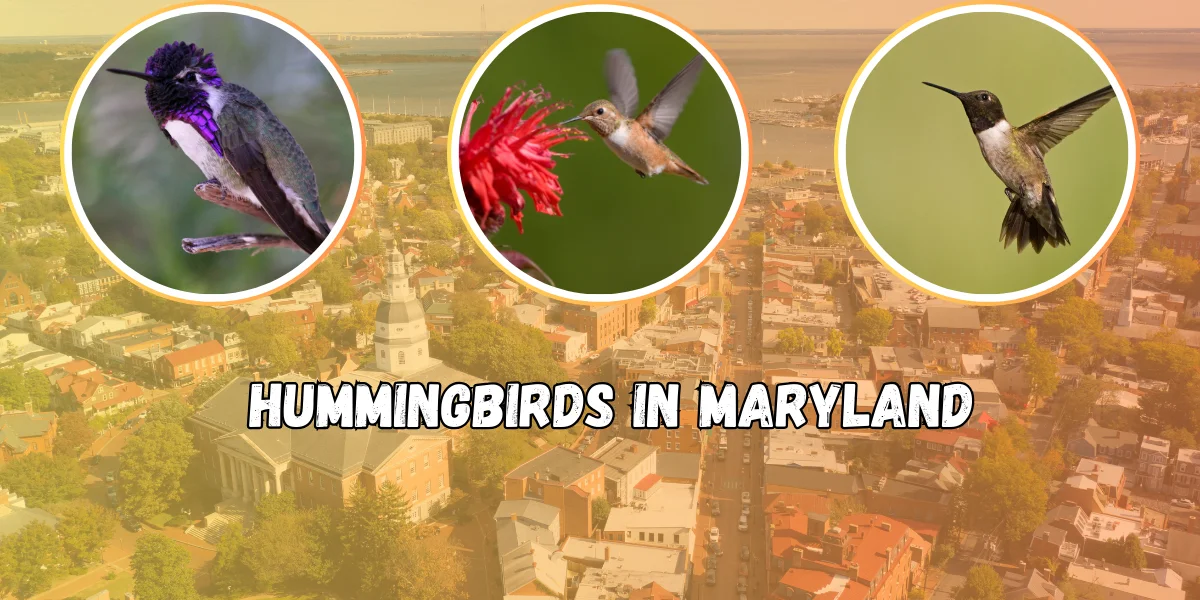
1 thought on “8 Hummingbirds in Maryland: List, Details & Photos”